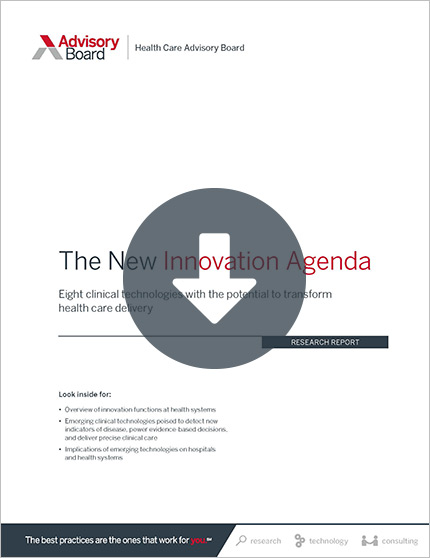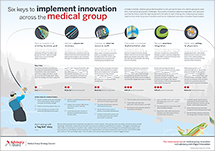Editor's note: This popular story from the Daily Briefing's archives was republished on April 25, 2019.
Read Advisory Board's take: Why seemingly revolutionary ideas never get past the drawing board
Cleveland Clinic released its annual list of the top 10 medical innovations the health system predicts will "transform health care in 2019."
For the list, a panel of Cleveland Clinic scientists and physicians, led by Cleveland Clinic's Chief Wellness Officer Michael Roizen sifted through over 100 nominations and interviewed dozens of scientists. The panel used that information to select the 10 up-and-coming innovations they predict will "significantly transform the medical field and improve care for patients at Cleveland Clinic and throughout the world," according to Roizen.
The top innovation
The panel predicts that alternative therapies for pain will be the most important innovation of 2019.
And research into the topic is underway at the Clinic. The Clinic is exploring innovative treatments for pain management, including aromatherapy, dietary changes, and stress management, to curb the number of unnecessary opioid prescriptions. Doctors are also employing pharmacogenomic testing, which analyzes a patient's genetic makeup to determine how well the patient will metabolize certain medication. This information can help prevent prescriptions for medications that might be ineffective at providing pain relief as well as prescriptions that could lead to adverse reactions.
The other selected innovations, listed in order of predicted impact, are:
Learn more about alternative therapies for pain with our report, Rightsizing Opioid Prescribing
- The advent of AI in health care
Artificial intelligence (AI), which health systems use to improve decision support, patient triage, and image analysis, is "a game changer" for the health care industry, according to Cleveland Clinic CIO Ed Marx. AI allows physicians to make better decisions regarding patient interventions, reduces physician burnout, and improves the image analysis process by "quickly making sense of the mountains of data within a physician's [EHR] system," the Clinic said in a release.
Learn more about AI with our report, The Artificial Intelligence Ecosystem
- Expanded window for acute stroke intervention
Recently released guidelines this year enforce an increased timeframe for stroke intervention, which will allow more recovery time and decrease the risk of disability for patients who suffer strokes.
Download ready-to-use slides on the latest neuroscience market trends
- Advances in Immunotherapy for cancer treatment
In the past few years, researchers have made important advances in immunotherapy, which triggers a patient's immune system to attack cancerous tumors. The Clinic expects that future discoveries of new immunotherapy targets and biomarkers will lead to more effective treatment methods for more types of cancer.
See the latest clinical innovations in medical, radiation, surgical, and interventional oncology
- Patient-specific products made through 3-D printing
3-D printing provides patients with customized medical devices—including airway stents, cranial implants, and external prosthetics—that are specific to the patients' dimensions and anatomy. These devices are more comfortable, improve performance outcomes, and are often more easily "accepted" by the patients' bodies, according to the Clinic. Tom Gildea of the Clinic's Respiratory Institute said, "This ability to impact patients' lives directly with technology specifically designed for them—that certainly is going to have great hope going forward in many different specialties."
- Virtual and mixed reality for medical education
Health systems are using virtual and mixed reality (VR/MR) to provide health professionals with simulation training to sharpen their practice. VR/MR uses audio, visual, and kinesthetic training to help health professionals "understand ... the 3-D relationship between various structures in the human body—down to the microscopic level," according to Neil Mehta, of the Clinic's Education Institute. Currently, Cleveland Clinic partners with Zygote Medical Education to develop 3-D anatomical models that future doctors will be able to access through a mobile device or desktop app to supplement other forms of medical training.
Read the briefing: Learn more about VR, including the pros, cons, use cases and adoption trends
- Visor for pre-hospital stroke diagnosis
A new hemorrhage scanning visor, which detects ruptured blood vessels in the brain, allows health professionals to quickly detect, diagnose, and treat hemorrhagic strokes—which cause almost 40% of stroke deaths.
Learn more: Access the neuroscience clinical technology compendium
- Innovation in robotic surgery
Robotized surgery can increase precision, lessen pain during recovery, and reduce recovery time, the Clinic said. Surgeons usually use robots for minimally invasive surgeries, but future advancements could authorize their usage for more complex procedures, according to the Clinic.
Read the blog post: 2 ways to optimize your robotics program
- Mitral and tricuspid valve percutaneous replacement and repair
Performing cardiac surgery through percutaneous intervention, or using a catheter in the skin, can reduce the pain, side effects, and trauma that follow invasive surgeries. According to the Clinic, percutaneous surgery increases the number of positive patient outcomes following cardiac surgery, inspiring researchers to consider using the method on a larger patient population.
- RNA-based therapies
With RNA-based gene therapies, scientists can detect and intercept genetic abnormalities in patients before translation. Scientists are exploring ways to use successful RNA therapies, like RNA interference and antisense nucleotides, to treat Huntington's disease, cancer, and neurologic diseases (Tye, WKYC3, 10/24; Roth, HealthLeaders Media, 10/24; Slabodkin, Health Data Management, 10/25).
Advisory Board's take

Rachel Woods, Senior Consultant, Medical Group Strategy Council
Many health systems are investing in innovative technologies and products in hopes of setting themselves apart from their competitors—but all too often, their seemingly revolutionary ideas never make it off the drawing board.
Why not? We've studied how dozens of health systems and medical groups approach innovation, and we've discovered that successful innovators embrace four key principles.
- Innovation is not the same as invention. Successful leaders avoid being distracted by the promise of a particularly exciting technology. Rather, they focus on the business problem that they hope to solve through innovation.
- Innovation without implementation will fail every time. Most leaders focus on coming up with an A+ idea, but even the best ideas will fail if they aren't matched with A+ execution. Leaders should prioritize the innovations best positioned to meet their strategic goals, even if that means focusing on only one innovation at a time.
- Physicians will be your best allies—or your worst critics. One of the biggest roadblocks to success is the ability to engage frontline physicians. Successful organizations establish a "physician visionary" to lead and advocate for innovation, collect early feedback from frontline physicians, and help leaders respond to ideas and concerns throughout rollout.
- Seamless physician workflow is non-negotiable. Physicians will resist solutions that require a change in their clinical behavior. At a minimum, innovation should avoid impeding physician workflow, and leaders should prioritize technologies that actually give physicians more patient-facing time.
As a health system leader, you might choose to pursue any of the innovations outlined by the Cleveland Clinic, or you might prefer to design their own new products. But either way, it's imperative to ground your innovations in an existing business challenge. Start by defining your goal. Then, engage physicians, and over-invest in implementation.
To learn more about key lessons for deploying disruptive technologies, download our new report on Attaining a First Mover Advantage Through Innovation.
Learn more: Six keys to implement innovation across the medical group
This infographic outlines the six keys to successfully implement innovation. Use the action steps as a guide to overcome common challenges in the implementation process.
Don't miss out on the latest Advisory Board insights
Create your free account to access 2 resources each month, including the latest research and webinars.
Want access without creating an account?
You have 2 free members-only resources remaining this month remaining this month.
1 free members-only resources remaining this month
1 free members-only resources remaining this month
You've reached your limit of free monthly insights
Become a member to access all of Advisory Board's resources, events, and experts
Never miss out on the latest innovative health care content tailored to you.
Benefits include:
You've reached your limit of free monthly insights



